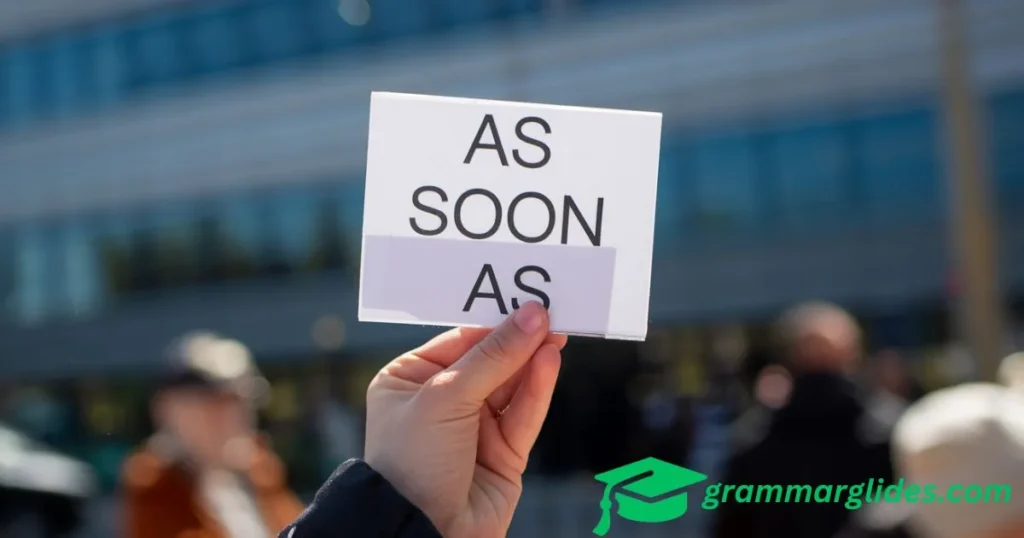“Communication is key choose your words wisely.”
In our daily interactions, the words we choose can greatly influence our message’s clarity and impact. One common phrase we often use is “right after.”
While it’s perfectly acceptable in casual conversation, formal writing requires a more polished vocabulary. In this blog post, we will explore 30 alternative phrases to convey the same meaning in a more sophisticated manner.
I encourage you to think about your own writing and communication styles. Are there areas where you could enhance your word choices? By using varied expressions, you not only elevate your writing but also engage your readers more effectively. Let’s embark on this journey to refine our language skills!
Understanding the nuances of language can make a significant difference in professional settings. By incorporating these alternatives, you can express yourself with confidence and precision. Whether you’re drafting an email, writing a report, or preparing a presentation, the right words can help you convey your message clearly.
30 Alternatives to “Right After”
1. Immediately Following
Scenario: In a formal meeting, you want to clarify the sequence of events.
Example 1: “The report will be submitted immediately following the review meeting.”
Example 2: “Please complete the task and submit it immediately following the deadline.”
Explanation: Using “immediately following” emphasizes urgency and precision, making it suitable for formal contexts.
2. Directly After
Scenario: You’re giving instructions for a project timeline.
Example 1: “You should begin the next phase directly after receiving feedback.”
Example 2: “We will hold a debriefing session directly after the event concludes.”
Explanation: This phrase denotes a clear sequence and maintains a formal tone.
3. Subsequently
Scenario: In a research paper, you need to outline steps.
Example 1: “The experiment was conducted, and subsequently, the data was analyzed.”
Example 2: “The committee met, and subsequently, they drafted the proposal.”
Explanation: “Subsequently” conveys a chronological order while sounding formal and academic.
4. Following That

Scenario: You’re presenting a timeline in a business report.
Example 1: “The initial phase will end, following that, we will initiate the next steps.”
Example 2: “The team will review the strategy, following that, they will implement changes.”
Explanation: This phrase is clear and maintains a structured format for formal writing.
5. Thereafter
Scenario: In a project update, you are describing milestones.
Example 1: “The proposal was approved; thereafter, we began implementation.”
Example 2: “The team completed the analysis, and thereafter, they presented their findings.”
Explanation: “Thereafter” provides a smooth transition to the next action, enhancing the flow of information.
6. At That Point
Scenario: You are detailing steps in a training manual.
Example 1: “You will assess the results; at that point, you can decide on the next steps.”
Example 2: “The team will reach a consensus; at that point, the project will move forward.”
Explanation: This phrase indicates a specific moment in time, making it ideal for formal documentation.
7. Right Subsequently
Scenario: In a formal letter, you’re outlining future actions.
Example 1: “We will address the issues, and right subsequently, we will implement solutions.”
Example 2: “The event will be evaluated, and right subsequently, recommendations will follow.”
Explanation: This phrase adds a sense of immediacy while remaining formal.
8. In Sequence

Scenario: You are explaining a process in a guide.
Example 1: “The tasks must be completed in sequence for optimal results.”
Example 2: “We will address each issue in sequence to ensure thoroughness.”
Explanation: “In sequence” conveys order, making it suitable for formal writing.
9. Following This
Scenario: In a project proposal, you want to outline next steps.
Example 1: “We will present our findings; following this, we will seek approval.”
Example 2: “The analysis will conclude; following this, recommendations will be made.”
Explanation: This phrase helps maintain clarity and flow in formal documents.
Other ways to say after careful consideration
10. Shortly After
Scenario: In an email update, you want to inform about upcoming actions.
Example 1: “The decision will be made; shortly after, we will notify all stakeholders.”
Example 2: “The meeting concludes; shortly after, the minutes will be distributed.”
Explanation: “Shortly after” indicates a brief time frame, suitable for formal communication.
11. Subsequently Thereafter
Scenario: You are writing a formal report and need to indicate a sequence.
Example 1: “The first phase will conclude; subsequently thereafter, we will begin the analysis.”
Example 2: “We will finalize the plans; subsequently thereafter, we will schedule the meeting.”
Explanation: This phrase adds a formal touch while indicating a clear progression of events.
12. Following Shortly
Scenario: In a training session, you describe a schedule.
Example 1: “The introduction will take place; following shortly, we will move to the next topic.”
Example 2: “The workshop begins; following shortly, we will have a Q&A session.”
Explanation: “Following shortly” indicates a brief interval, maintaining professionalism.
13. In the Wake Of
Scenario: You are discussing consequences in a formal paper.
Example 1: “In the wake of the decision, several changes will be implemented.”
Example 2: “In the wake of the incident, an investigation will follow.”
Explanation: This phrase adds a serious tone, making it suitable for formal discussions.
14. Immediately Thereafter
Scenario: You are outlining steps in a process document.
Example 1: “The proposal was submitted; immediately thereafter, the review process began.”
Example 2: “The training will occur; immediately thereafter, feedback will be gathered.”
Explanation: This phrase emphasizes urgency, making it appropriate for formal writing.
15. Subsequently Following

Scenario: You are summarizing a sequence in a report.
Example 1: “The team will complete their tasks; subsequently following, they will evaluate the results.”
Example 2: “We will conduct research; subsequently following, we will present our findings.”
Explanation: This phrase maintains a formal tone while indicating a clear order.
16. Then
Scenario: In a formal document, you are describing a series of events.
Example 1: “The team will finish the project; then, they will prepare the final report.”
Example 2: “We will conduct the analysis; then, we will discuss the implications.”
Explanation: “Then” is straightforward and effective in formal contexts.
17. Right Subsequently After
Scenario: You are drafting a protocol for a procedure.
Example 1: “The test will commence; right subsequently after, we will analyze the results.”
Example 2: “The initial meeting will end; right subsequently after, we will draft the summary.”
Explanation: This phrase maintains clarity while emphasizing immediacy.
18. Directly Subsequently
Scenario: In a formal report, you outline steps taken.
Example 1: “The meeting concluded; directly subsequently, we took action.”
Example 2: “The survey was completed; directly subsequently, we analyzed the feedback.”
Explanation: This phrase provides a clear sense of order in formal writing.
19. Following Immediately
Scenario: In a professional email, you want to clarify timing.
Example 1: “We will review the documents; following immediately, we will provide feedback.”
Example 2: “The team will finalize the plans; following immediately, we will set a date.”
Explanation: This phrase indicates a clear and prompt sequence of actions.
Other Ways to Politely Request Monetary Gifts
20. Right Away
Scenario: In a business proposal, you describe the next steps.
Example 1: “Once we receive approval, we will start the project right away.”
Example 2: “The training will begin, and we will implement changes right away.”
Explanation: “Right away” conveys a sense of urgency, suitable for professional contexts.
21. Concurrently
Scenario: In a project plan, you want to indicate simultaneous actions.
Example 1: “We will conduct the training concurrently with the project rollout.”
Example 2: “The marketing campaign will run concurrently with product development.”
Explanation: This phrase is useful for expressing parallel activities in formal writing.
22. As Soon As

Scenario: In a report, you need to outline timing.
Example 1: “The analysis will begin as soon as the data is collected.”
Example 2: “The meeting will start as soon as everyone arrives.”
Explanation: “As soon as” indicates promptness, making it suitable for formal documentation.
23. Promptly After
Scenario: You’re writing a protocol for an event.
Example 1: “The opening remarks will be made; promptly after, we will proceed with the agenda.”
Example 2: “The review will take place; promptly after, we will send out minutes.”
Explanation: This phrase emphasizes prompt action, suitable for formal contexts.
24. Instantly After
Scenario: In a technical document, you describe procedures.
Example 1: “The system will notify users; instantly after, updates will be applied.”
Example 2: “Users will receive a confirmation; instantly after, they can proceed.”
Explanation: “Instantly after” conveys immediacy, making it ideal for technical writing.
25. Next
Scenario: In a formal outline, you are describing steps.
Example 1: “The team will finish the assessment; next, they will compile the results.”
Example 2: “The meeting will conclude; next, we will discuss the action items.”
Explanation: “Next” is simple yet effective for indicating order in formal writing.
26. Shortly Thereafter
Scenario: In a business email, you outline your intentions.
Example 1: “The project will start; shortly thereafter, we will evaluate progress.”
Example 2: “The meeting will conclude; shortly thereafter, we will issue a report.”
Explanation: This phrase indicates a brief interval, making it suitable for formal communication.
27. Subsequently
Scenario: In a presentation, you discuss project timelines.
Example 1: “The prototype will be developed; subsequently, testing will begin.”
Example 2: “We will assess the feedback; subsequently, we will implement improvements.”
Explanation: This word maintains a formal tone while indicating a clear progression.
28. Henceforth

Scenario: You’re drafting a policy document.
Example 1: “All employees must follow the new guidelines; henceforth, compliance is mandatory.”
Example 2: “We will implement the changes; henceforth, all reports will be submitted electronically.”
Explanation: “Henceforth” conveys a sense of formality and authority.
29. Thereafter
Scenario: In a legal document, you need to outline actions.
Example 1: “The contract was signed; thereafter, the terms will be enforced.”
Example 2: “The decision was made; thereafter, all parties will be notified.”
Explanation: This phrase denotes a clear sequence, making it suitable for formal contexts.
30. Afterward
Scenario: In a summary, you need to clarify actions.
Example 1: “The analysis will conclude; afterward, we will schedule a meeting.”
Example 2: “The presentation will end; afterward, we will have a Q&A session.”
Explanation: “Afterward” is straightforward and effective in formal writing.
Conclusion:
In conclusion, mastering the various ways to say “right after” can significantly enhance your formal communication. By using these alternatives, you can convey your message with clarity and professionalism.
Incorporating varied vocabulary into your writing not only enriches your expression but also demonstrates your linguistic proficiency. Start applying these phrases today to elevate your formal writing style!

Hi! I’m Lauren Reynolds, the author of Grammar Glides. I create easy-to-follow content that helps you master English with confidence. Let’s make learning English simple and enjoyable together!

